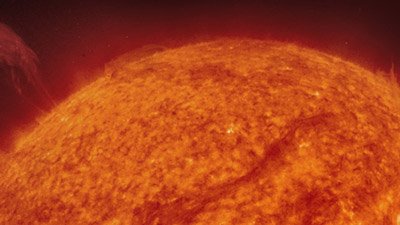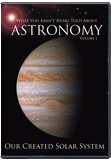Is the Sun Shrinking?
Some biblical creationists have suggested the sun is shrinking, which is unlikely—but that still doesn't mean a nuclear-powered sun is billions of years old.
What Powers the Sun?
The 19th century saw the first scientific explanation for the sun’s energy. William Thomson (Lord Kelvin) and Hermann von Helmholtz proposed that the sun derived its energy from the conversion of gravitational potential energy. This process (now called the Kelvin-Helmholtz mechanism) would cause the sun slowly to shrink, but the shrinkage would be so gradual as to be virtually undetectable. The Kelvin-Helmholtz mechanism is a viable model, and astronomers think that all stars derive at least some of their energy from this mechanism at some stages. However, scientists generally rejected the Kelvin-Helmholtz model toward the end of the 19th century because it could power the sun for “at most” 30 million years. At that time, many scientists were committed to gradual geological and biological evolution, processes that required much more time than the Kelvin-Helmholtz mechanism would allow.
If the conversion of gravitational potential energy does not power the sun, then what does? Early in the 20th century, astronomers began to suggest some sort of nuclear power source for the sun. Eventually, increased knowledge of nuclear physics revealed that the fusion of hydrogen into helium in the solar core is the most likely source of the sun’s energy. The sun contains abundant hydrogen for fuel, and from physics we know that the conditions in the solar core are sufficient to sustain the fusion of hydrogen into helium. If this is the source of the sun’s energy, it could power the sun for nearly 10 billion years.
If the sun is powered by gravity rather than a nuclear source, then the sun, and presumably the earth, must be far younger than the 4.5 billion years that most scientists think that they are.
In 1979, two scientists presented a brief paper at a meeting of the American Astronomical Society, in which they presented evidence that the sun may be shrinking. Astronomers immediately were skeptical, and much discussion resulted. Consequently, very good arguments and data that contradicted this result came forth. Ignoring these subsequent papers, many creationists seized upon the original presentation as evidence of recent creation. If the sun is powered by gravity rather than a nuclear source, then the sun, and presumably the earth, must be far younger than the 4.5 billion years that most scientists think that they are. This would preclude biological and geological evolution that most scientists believe today. But was this paper correct? The shrinking sun hypothesis was thoroughly investigated in the creation literature and was found wanting.
The Solar Neutrino Problem
Along the way there was another wrinkle. If the sun is powered by nuclear reactions, it would be good to test this directly. However, these reactions occur deep inside the sun, near its center. We receive radiation from the solar surface, a few hundred thousand miles higher, so we cannot directly observe the solar core. Or can we? A byproduct of the nuclear reactions in the solar core is an elusive little particle called a neutrino. Neutrinos do not easily interact with other matter. Therefore, as the solar neutrinos are produced in the solar core, they easily escape the sun, passing through the sun’s outer layers as if they weren’t there. Hence solar neutrinos arrive on earth about eight minutes after they were created in the solar core.
If we can create a solar neutrino detector here on earth, we can directly measure the nuclear reactions that power the sun. Solar neutrino detectors operate by stacking the deck, as it were, by assembling large amounts of material that are far more likely to interact with neutrinos. Still, only a few neutrinos interact, with most neutrinos slipping by undetected. By our knowledge of neutrino physics, we can convert the measured flux of solar neutrinos into the actual flux. The first solar neutrino experiment began operating a half-century ago. The early results indicated that the sun is producing only about one-third the amount predicted. Over the next 35 years, other solar neutrino experiments went into operation, and they produced similar results. This became known as the solar neutrino problem: why was the sun producing only one-third of the neutrinos expected? Some creationists suggested that the solar neutrino problem indicated that the sun is young. If the sun is deriving its energy only partly from nuclear fusion, then the other two-thirds probably is gravitational contraction. But that is an unstable state–as the sun contracted, the rate of nuclear fusion would increase, eventually accounting for all of the sun’s energy. This could happen only if the sun were young, but it could not happen if the sun were more than a few tens of millions of years old.
The Solar Neutrino Problem Solved
Evolutionary scientists pursued other explanations for the solar neutrino problem. The preferred model of neutrinos was that they traveled at the speed of light and had no rest mass. However, an alternate theory was that neutrinos have very tiny mass and consequently travel just slightly slower than the speed of light. Another consequence of this alternate theory is that neutrinos oscillate between the three types. The sun produces only one type of neutrino, and solar neutrino experiments were sensitive only to that one type. But if neutrinos oscillate between the three types, then only about one-third of the type of neutrino produced by the sun would be present by the time they reached the earth, because two-thirds would have converted to the other two types. Astronomers liked the alternate neutrino theory as the solution to the solar neutrino problem, but particle physicists liked the preferred model (making it by definition the preferred model) and thought that the astronomers’ theory of the sun was in error. Resolution to the solar neutrino problem came in 2001 when researchers produced evidence that the alternate neutrino theory was correct after all. This meant that we were detecting only a third of the predicted solar neutrinos because that was all that survived after their eight-minute journey from the sun.
Since the predicted and measured neutrino fluxes from the sun match, it is clear that the sun derives its energy from fusion of hydrogen into helium and not from gravitational contraction.
With the solar neutrino problem solved, there is no reason to doubt that the sun is deriving its energy from fusion of hydrogen into helium in its core. In fact, while the early solar neutrino experiments could not directly confirm that we were receiving any neutrinos from the sun, later experiments convincingly showed that we were. This is because the early experiments could merely measure detections of neutrinos, but not the directions that the neutrinos were moving. However, later experiments were able to measure direction of travel, and they showed that neutrinos were moving away from the sun. Since the predicted and measured neutrino fluxes from the sun match, it is clear that the sun derives its energy from fusion of hydrogen into helium and not from gravitational contraction. Therefore, we urge creationists not to use the shrinking sun as evidence that the sun is young.
Conclusion
Does the nuclear source of the sun indicate that the sun is billions of years old? Not at all. A nuclear energy source merely means that the sun could last for billions of years, but not that the sun is necessarily that old. A young nuclear-powered sun may be more stable than a sun powered by the Kelvin-Helmholtz mechanism. This could be evidence of God’s design in the sun.
Recommended Resources

Answers in Genesis is an apologetics ministry, dedicated to helping Christians defend their faith and proclaim the good news of Jesus Christ.
- Customer Service 800.778.3390
- © 2025 Answers in Genesis







